Training Data for My Second Marathon
In this post, I will talk about my preparation for my second marathon and share some data on my training.
I ran my first marathon in May 2023 with a time of 4 hours and 56 minutes. Finishing a marathon is not a simple feat, but still I felt upset with the outcome. I think I was too ambitious about my goal of 3 hours and 30 minutes, and too optimistic about my fitness level back then. Leading up to the race, my weekly training volume was only 40-50 km spread across three runs. During the first hour of the race I realized it was not enough at all. Here is how my heart rate and pace looked like during the race:
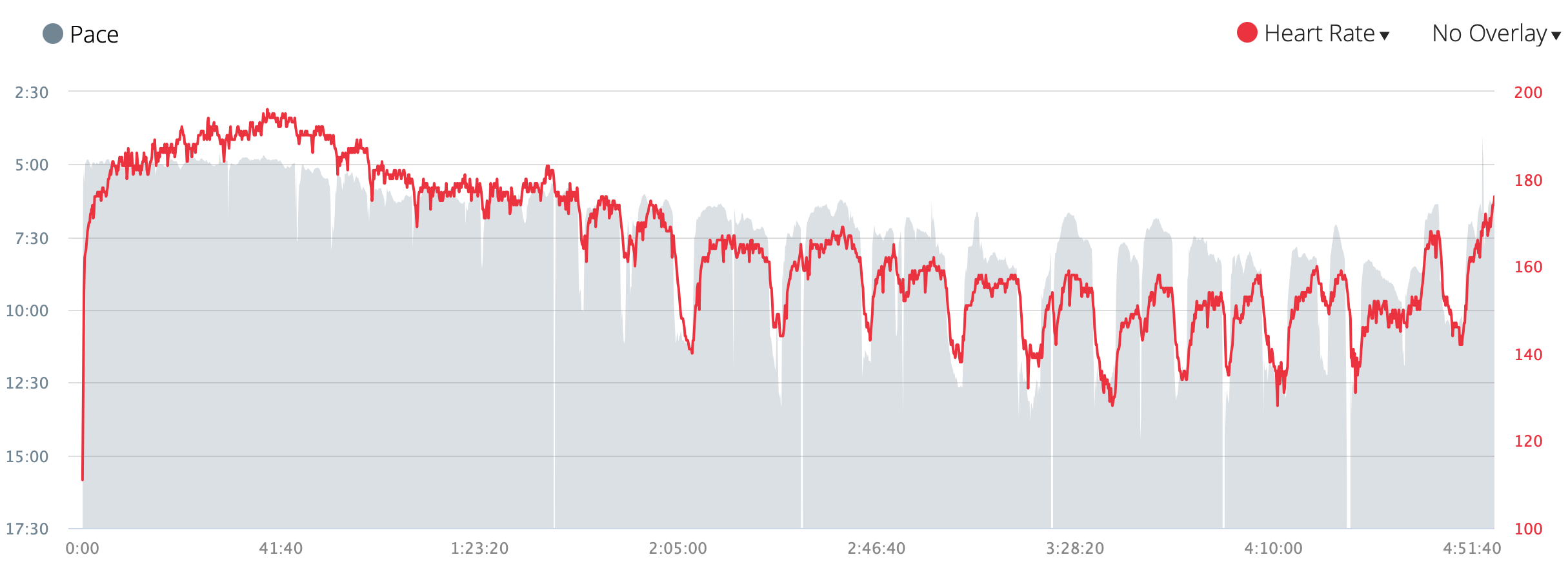
Honestly, I do not know what I was thinking in the first 40 minutes. Running at a 5:00/km pace would be enough to achieve a 3 hours 30 minutes finish time. When I realized I had not trained enough, it was too late and slowing down (having to slow down) and taking walk breaks only prolonged the agony. Here is a breakdown of each kilometer split in relation to my heart rate, the measurements were taken by my Garmin watch:
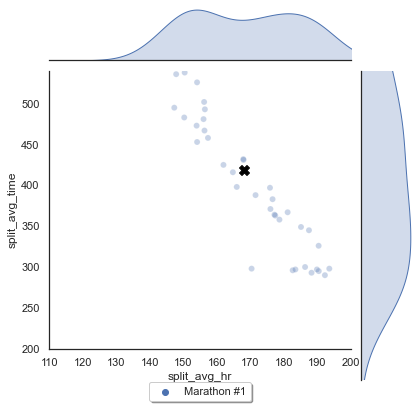
Pace and heart rate all over the place! The average of all the splits is marked by the black cross.
After the disappointing result, I wanted to train again, and this time more properly. I got a chest strap heart rate monitor to ensure more accurate and timely heart rate measurements. I also wanted to run at an easier pace this time, around 140 bpm. For my first marathon, I was running at 156 bpm during the “easy” runs.
I then signed up for the Madison Marathon on November 12. That meant I had 26 weeks to train. With most marathon training plans spanning 16 to 20 weeks, I had plenty of time. I found a marathon training plan online. After some mile-to-km conversions and rounding up the numbers, I ended up with a previous version of the table below. Although rarely, I had to skip runs or adjust the daily volume. After 26 weeks my training looked like this:
| Week number | Weekly volume | Monday | Tuesday | Wednesday | Thursday | Friday | Saturday | Sunday |
|---|---|---|---|---|---|---|---|---|
| 1 | 37 | 10 e | 10 e | 9 e | 8 1:2interval | - | - | - |
| 2 | 48 | 6 r | 10 tempo | 6.5 e | 6.5 e | 6 r | 13, last 2 mp | - |
| 3 | 55 | 7 e | 10 tempo | 9 e | 6 interval | 7 r | 16 | - |
| 4 | 39 | - | - | 9 e | 9 e | - | - | 21 race |
| 5 | 57 | - | 10 tempo | 9 e | 8 interval | 9 e | 20, last 1 mp | - |
| 6 | 57 | 9 e | 10 tempo | 8 interval | 9 e | 21 | - | - |
| 7 | 70 | 10 e | 10 tempo | 10 e | 9 interval | 10 e | 21 long | - |
| 8 | 70 | - | 12 tempo | 12 e | 12 e | 12 e | 22 long | - |
| 9 | 77 | 12 e | 9 tempo | 12 e | 9 interval | 12 e | 23 long | - |
| 10 | 80 | 13 e | 10 e | 12 tempo | 11 e | 11 e | 23 long | - |
| 11 | 40 | - | 11 e | 11 e | 11 e | - | - | 7 e |
| 12 | 72 | 12 e | 12 e | 12 e | 12 e | 12 e | 12 e | - |
| 13 | 85 | 4 tempo 9 e | 13 e | 13 e | 11 tempo | 10 e | - | 25 long |
| 14 | 85 | 13 e | 14 tempo | 13 e | - | - | 30 long | 15 e |
| 15 | 56 | 15 e | - | - | 11 e | 15 e | 15 e | - |
| 16 | 90 | 13 e | 14 tempo | 13 e | - | 26 long | 13 e | 11 e |
| 17 | 82 | - | 13 e | 7 | 15 e | 15 e | - | 32 long |
| 18 | 68 | - | 14 e | 13 e | 15 e | 14 tempo | 12 e | - |
| 19 | 101 | - | 13 interval | 14 e | 14 e | 14 e | 13 tempo | 33 long |
| 20 | 102 | - | 15 e | 15 tempo | 15 e | 13 interval | 14 e | 30 long |
| 21 | 50 | - | - | 11 e 11 e | - | 14 interval | 14 e | - |
| 22 | 104 | - | 15 e | 14 interval | 15 e | 15 e | 15 e | 30 long 2 race |
| 23 | 106 | - | 15 e | 14 interval | 15 e | 15 e | 15 e | 32 long 5 race |
| 24 | 80 | - | 12 e | 10 e | 13 e | 12 interval | 12 e | 21 long |
| 25 | 38 | - | 10 e | 10 e 6 race | 10 e | - | 8 e | - |
| 26 | 11 | - | - | 6 e | - | - | 5 shakeout | 42 race 1 e |
Table legend:
- “e”: Easy runs where I tried to keep my heart rate below 136.
- “Long”: Typically longer than 20 km and heart rate below 145.
- “Tempo”: Between 5:00-5:30/km pace.
- “Interval”: Splits of 1 km, 1.25 km, 400 m with 1:1 run:rest.
- “Race”: Race tempo, meaning 5:00/km pace.
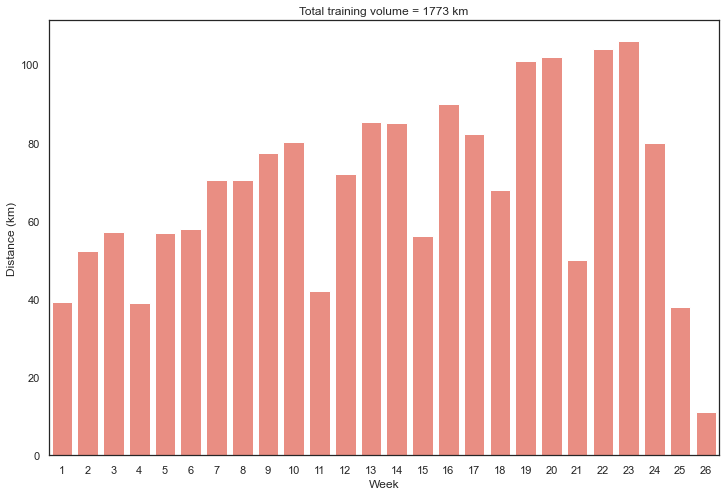
I think having 6 30+ km long runs in this training phase was crucial. During these runs, I gained a better understanding of my body’s cues, e.g. knowing precisely when to drink water, when to take gels, ideal frequency for both… In contrast, I had only one such run for my first marathon.
By the end of my training, I logged a total of 1773 km. Here is how the distribution looks like:

And finally, here is how the 1773 km look like with respect to pace and heart rate.

Half Marathon #2 represents the half marathon race I completed in Seattle in the fourth week of training. I ran it in 1 hour and 44 minutes, setting a new PB by one minute despite a very hilly course (358 m elevation gain). I placed third in my age group and earned myself a commemorative award. The improvement compared to the first marathon is strikingly evident: The splits are closely grouped together. It becomes even more evident with the graph below:
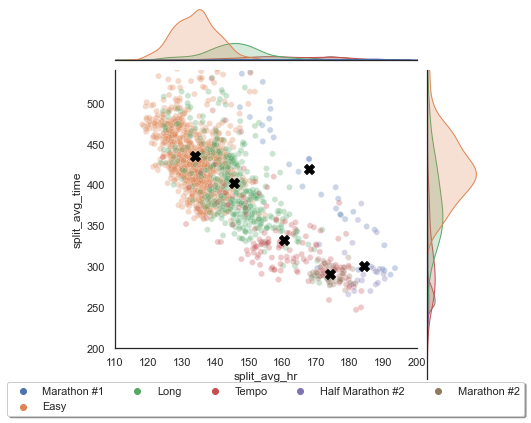
I finished my second marathon in 3 hours and 25 minutes with an average pace of 4:52/km and average heart rate of 174 bpm. Compared to Half Marathon #2, there is a 0:10/km pace and 10 bpm heart rate improvement despite the distance being twice as long. Seeing this improvement, and the stark difference in the graphs below (top: #2, bottom: #1) motivates me to run more.
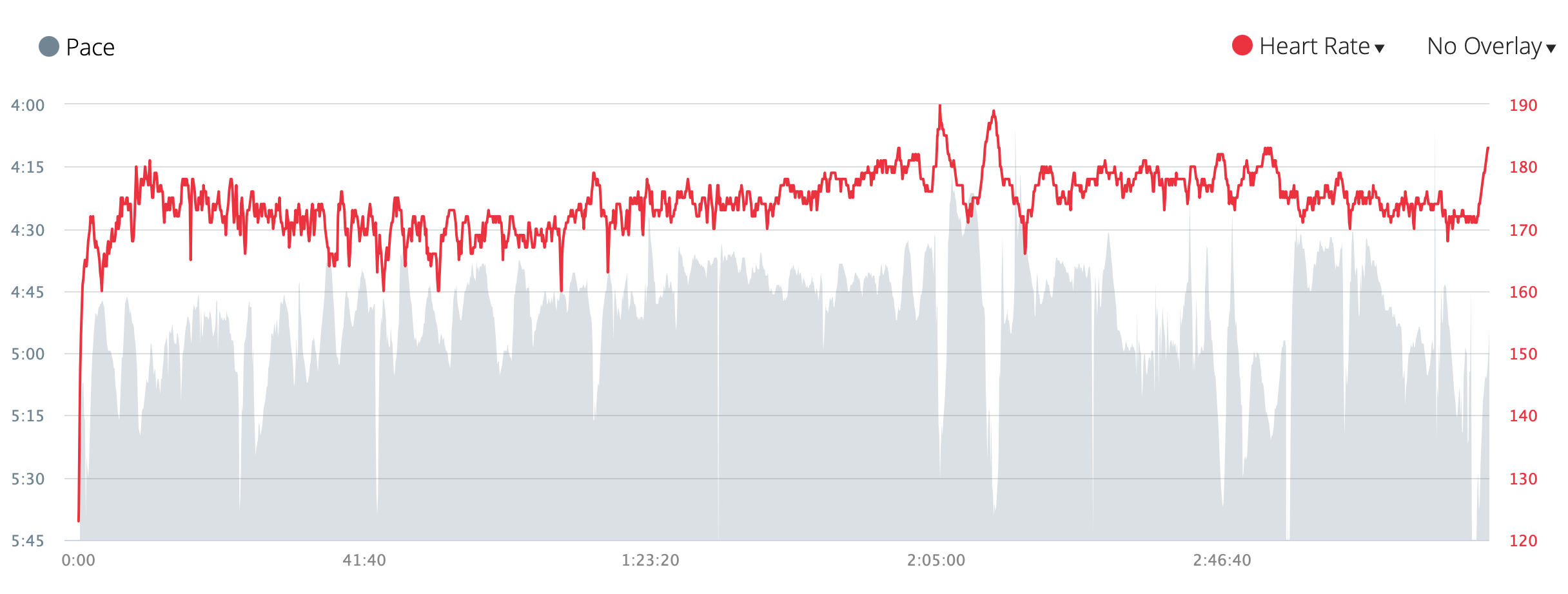

Here is what I am planning to do after taking a 2-3 weeks of rest:
- I will ramp up my weekly volume gradually and reach 80 km per week.
- I will do my easy runs at an even easier pace, around 127 bpms.
- I will see how having 1 interval and 1 tempo sessions each week affects my body.
- I will work on maintaining a steady effort for longer time. This will make the gaps between my splits smaller during the race.
- I will aim for a marathon in Fall 2024 with 2 hours 55 minutes finishing time.
- In the meantime, I will do some strength workouts.
Some time soon, I will also write about my opinions on “The Big Book of Endurance Training and Racing” by Philip Maffetone.
